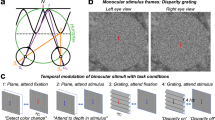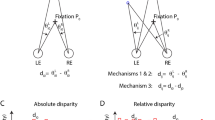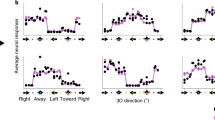Abstract
One of the fundamental challenges of binocular vision is that objects project to different positions on the two retinas (binocular disparity). Neurons in visual cortex show two distinct types of tuning to disparity, position and phase disparity, which are the results of differences in receptive field location and profile, respectively. Here, we point out that phase disparity does not occur in natural images. Why, then, should the brain encode it? We propose that phase-disparity detectors help to work out which feature in the left eye corresponds to a given feature in the right. This correspondence problem is plagued by false matches: regions of the image that look similar, but do not correspond to the same object. We show that phase-disparity neurons tend to be more strongly activated by false matches. Thus, they may act as 'lie detectors', enabling the true correspondence to be deduced by a process of elimination.
This is a preview of subscription content, access via your institution
Access options
Subscribe to this journal
Receive 12 print issues and online access
$209.00 per year
only $17.42 per issue
Buy this article
- Purchase on Springer Link
- Instant access to full article PDF
Prices may be subject to local taxes which are calculated during checkout






Similar content being viewed by others
References
Ohzawa, I., DeAngelis, G.C. & Freeman, R.D. Stereoscopic depth discrimination in the visual cortex: neurons ideally suited as disparity detectors. Science 249, 1037–1041 (1990).
DeAngelis, G.C., Ohzawa, I. & Freeman, R.D. Depth is encoded in the visual cortex by a specialised receptive field structure. Nature 352, 156–159 (1991).
Anzai, A., Ohzawa, I. & Freeman, R.D. Neural mechanisms underlying binocular fusion and stereopsis: position vs. phase. Proc. Natl. Acad. Sci. USA 94, 5438–5443 (1997).
Anzai, A., Ohzawa, I. & Freeman, R.D. Neural mechanisms for encoding binocular disparity: receptive field position versus phase. J. Neurophysiol. 82, 874–890 (1999).
Livingstone, M.S. & Tsao, D.Y. Receptive fields of disparity-selective neurons in macaque striate cortex. Nat. Neurosci. 2, 825–832 (1999).
Prince, S.J., Cumming, B.G. & Parker, A.J. Range and mechanism of encoding of horizontal disparity in macaque V1. J. Neurophysiol. 87, 209–221 (2002).
Fleet, D.J., Wagner, H. & Heeger, D.J. Neural encoding of binocular disparity: energy models, position shifts and phase shifts. Vision Res. 36, 1839–1857 (1996).
Orban, G.A., Janssen, P. & Vogels, R. Extracting 3D structure from disparity. Trends Neurosci. 29, 466–473 (2006).
Bredfeldt, C.E. & Cumming, B.G. A simple account of cyclopean edge responses in macaque V2. J. Neurosci. 26, 7581–7596 (2006).
Nienborg, H., Bridge, H., Parker, A.J. & Cumming, B.G. Receptive field size in V1 neurons limits acuity for perceiving disparity modulation. J. Neurosci. 24, 2065–2076 (2004).
von der Heydt, R., Zhou, H. & Friedman, H.S. Representation of stereoscopic edges in monkey visual cortex. Vision Res. 40, 1955–1967 (2000).
Hinkle, D.A. & Connor, C.E. Three-dimensional orientation tuning in macaque area V4. Nat. Neurosci. 5, 665–670 (2002).
Nguyenkim, J.D. & DeAngelis, G.C. Disparity-based coding of three-dimensional surface orientation by macaque middle temporal neurons. J. Neurosci. 23, 7117–7128 (2003).
Janssen, P., Vogels, R. & Orban, G.A. Three-dimensional shape coding in inferior temporal cortex. Neuron 27, 385–397 (2000).
Taira, M., Tsutsui, K.I., Jiang, M., Yara, K. & Sakata, H. Parietal neurons represent surface orientation from the gradient of binocular disparity. J. Neurophysiol. 83, 3140–3146 (2000).
Tyler, C.W. Depth perception in disparity gratings. Nature 251, 140–142 (1974).
Prince, S.J., Eagle, R.A. & Rogers, B.J. Contrast masking reveals spatial-frequency channels in stereopsis. Perception 27, 1345–1355 (1998).
Haefner, R. & Cumming, B.G. Spatial nonlinearities in V1 disparity-selective neurons. Soc. Neurosci. Abstr. 583.9 (2005).
Read, J.C.A. A Bayesian model of stereopsis depth and motion direction discrimination. Biol. Cybern. 86, 117–136 (2002).
Read, J.C.A. A Bayesian approach to the stereo correspondence problem. Neural Comput. 14, 1371–1392 (2002).
Tsai, J.J. & Victor, J.D. Reading a population code: a multi-scale neural model for representing binocular disparity. Vision Res. 43, 445–466 (2003).
Chen, Y. & Qian, N. A coarse-to-fine disparity energy model with both phase-shift and position-shift receptive field mechanisms. Neural Comput. 16, 1545–1577 (2004).
Read, J.C.A. & Cumming, B.G. Ocular dominance predicts neither strength nor class of disparity selectivity with random-dot stimuli in primate V1. J. Neurophysiol. 91, 1271–1281 (2004).
Cumming, B.G. & DeAngelis, G.C. The physiology of stereopsis. Annu. Rev. Neurosci. 24, 203–238 (2001).
Freeman, R.D. & Ohzawa, I. On the neurophysiological organisation of binocular vision. Vision Res. 30, 1661–1676 (1990).
Poggio, G.F. & Fischer, B. Binocular interaction and depth sensitivity of striate and prestriate cortex of behaving rhesus monkey. J. Neurophysiol. 40, 1392–1405 (1977).
Qian, N. Computing stereo disparity and motion with known binocular cell properties. Neural Comput. 6, 390–404 (1994).
Poggio, G.F., Motter, B.C., Squatrito, S. & Trotter, Y. Responses of neurons in visual cortex (V1 and V2) of the alert macaque to dynamic random-dot stereograms. Vision Res. 25, 397–406 (1985).
Qian, N. & Zhu, Y. Physiological computation of binocular disparity. Vision Res. 37, 1811–1827 (1997).
Qian, N. Binocular disparity and the perception of depth. Neuron 18, 359–368 (1997).
Sanger, T. Stereo disparity computation using Gabor filters. Biol. Cybern. 59, 405–418 (1988).
Marr, D. & Poggio, T. A computational theory of human stereo vision. Proc. R. Soc. Lond. B 204, 301–328 (1979).
Smallman, H.S. & MacLeod, D.I. Spatial scale interactions in stereo sensitivity and the neural representation of binocular disparity. Perception 26, 977–994 (1997).
Rohaly, A.M. & Wilson, H.R. Nature of coarse-to-fine constraints on binocular fusion. J. Opt. Soc. Am. A Opt. Image Sci. Vis. 10, 2433–2441 (1993).
Prince, S.J. & Eagle, R.A. Size-disparity correlation in human binocular depth perception. Proc. Biol. Soc. 266, 1361–1365 (1999).
Prince, S.J.P. & Eagle, R.E. Weighted directional energy model of human stereo correspondence. Vision Res. 40, 1143–1155 (2000).
Read, J.C.A. & Cumming, B.G. Testing quantitative models of binocular disparity selectivity in primary visual cortex. J. Neurophysiol. 90, 2795–2817 (2003).
DeValois, R.L., Albrecht, D.G. & Thorell, L.G. Spatial frequency selectivity of cells in macaque visual cortex. Vision Res. 22, 545–559 (1982).
Cumming, B.G., Shapiro, S.E. & Parker, A.J. Disparity detection in anticorrelated stereograms. Perception 27, 1367–1377 (1998).
Cogan, A.I., Lomakin, A.J. & Rossi, A.F. Depth in anticorrelated stereograms: effects of spatial density and interocular delay. Vision Res. 33, 1959–1975 (1993).
Julesz, B. Foundations of Cyclopean Perception (University of Chicago Press, Chicago, 1971).
Rogers, B. & Anstis, S. Reversed depth from positive and negative stereograms. Perception 4, 193–201 (1975).
Scharstein, D. & Szeliski, R. A taxonomy and evaluation of dense two-frame stereo correspondence algorithms. Int. J. Comput. Vis. 47, 7–42 (2002).
Parker, A. Misaligned viewpoints. Nature 352, 109 (1991).
Jepson, A.D. & Jenkin, M.R.M. The fast computation of disparity from phase differences. in Computer Vision and Pattern Recognition, 1989. Proceedings CVPR '89., IEEE Computer Society Conference on., 389–403 (San Diego, California, USA, 1989).
Fleet, D.J. Disparity from local weighted phase-correlation. in Systems, Man, and Cybernetics, 1994. 'Humans, Information and Technology'., 1994 IEEE International Conference on. 1, 48–54 (San Antonio, Texas, USA, 1994).
Acknowledgements
J.C.A.R. performed all analyses and simulations and wrote the manuscript. B.G.C. supervised the project.
Author information
Authors and Affiliations
Corresponding author
Supplementary information
Supplementary Text and Figures
Supplementary Figures 1–6, Supplementary Note (PDF 6781 kb)
Rights and permissions
About this article
Cite this article
Read, J., Cumming, B. Sensors for impossible stimuli may solve the stereo correspondence problem. Nat Neurosci 10, 1322–1328 (2007). https://doi.org/10.1038/nn1951
Received:
Accepted:
Published:
Issue Date:
DOI: https://doi.org/10.1038/nn1951
This article is cited by
-
Binocular integration and stereopsis in children with television torticollis
BMC Ophthalmology (2021)
-
The effect of image position on the Independent Components of natural binocular images
Scientific Reports (2018)
-
A spiking neural network model of 3D perception for event-based neuromorphic stereo vision systems
Scientific Reports (2017)
-
The binocular neural mechanism: disparity coding schemes and population coding
Science China Information Sciences (2015)



